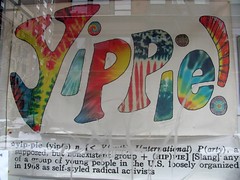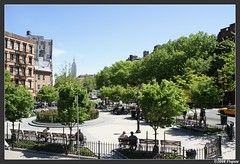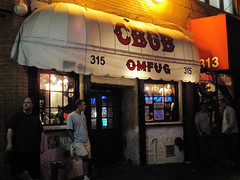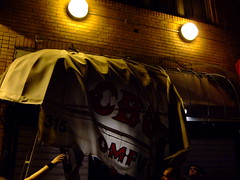North:
War Resisters League Building

51 (corner): Also known as the Peace Pentagon,
the War Resisters moved here in 1969 when their
landlord at 6 Beekman Place asked them to leave after a police raid. Houses other radical groups like
Nicaragua Network and Paper Tiger TV.
On the ground floor are KD and Spooly D's--the latter a sewing supply
store whose name seems to be a pun on Schooly D, the guy who invented gangsta rap.
45: Culture Project Theater
33: Zero Maria Carnejo, designer boutique
that moved here from Mott Street. This is the site of
Herman Melville's boyhood home; his
novel Pierre is largely based on his own childhood
here.
21: Site of The Florence Night Mission for Fallen Women
17-19: A neo-classical building from 1909. Houses Q Hair;
and 17 Bleecker coffeehouse (formerly Theeee
Coffee Chamber) was David Davis Artist Materials & Services.
15: Ina, designer consignment store.
This building and the two to its east were built by 1825;
this one was given an Art Deco redesign in 1928.
11: Quartino Bottega Organica, organic restaurant.

9: An 1884 Renaissance Revival building by
Frederick C. Withers, who co-designed the Jefferson
Market Courthouse. Since 1973, this has been the
headquarters of the Youth International Party, aka the Yippies.
Note faded
Yipster Times logo above door.
Window has info on
ibogaine, psychedelic heroin cure.
7: Built c. 1816, this building's first owner
was James Roosevelt, Franklin's great-grandfather. By
1855, it had been redesigned from Federal to Italianate
style. It's long been a studio for photographer
Robert Frank.
5: Bianca, rustic Italian, was Acquario.
The buildings from here to the Bowery were originally
Italianate rowhouses built in 1869 (David and John
Jardine, architects; John Murtha, builder).
3: Von, cozy beer-and-wine bar;
best site for first dates, says Time Out NY
1 (corner): Agozar, Cuban restaurant and lounge
|  Named for the
pastor (1900- 35) of Our Lady of Pom- peii.
Noted for his outreach to immigrants and
his rallying to the Triangle Shirtwaist Fire victims.
Named for the
pastor (1900- 35) of Our Lady of Pom- peii.
Noted for his outreach to immigrants and
his rallying to the Triangle Shirtwaist Fire victims.



